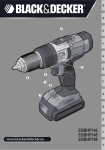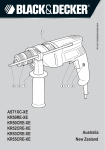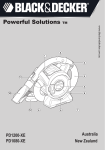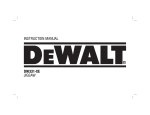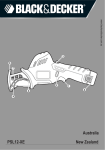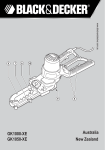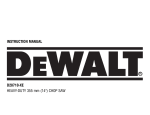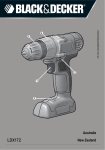Download Black & Decker F63E Instruction manual
Transcript
www.blackanddecker.com.au EGBHP188 Australia New Zealand 10 B A C 5 D 2 E ENGLISH Your Black & Decker drill/screwdriver has been designed for screwdriving applications and for drilling in wood, metal, plastics and soft masonry. This tool is intended for consumer use only. @ electric shock. Use of an RCD reduces the risk of A moment of inattention while operating power tools may result in serious personal injury. Failure to follow the warnings and instructions listed below may result in electric shock, Protective equipment such as dust mask, non-skid safety shoes, hard hat, or hearing protection used for appropriate conditions will reduce personal injuries. The term "power tool" in all of the warnings listed below refers to your mains operated (corded) power tool or battery operated (cordless) power tool. areas invite accidents. Cluttered or dark Power tools create sparks which may ignite the dust or fumes. energising power tools that have the switch on invites accidents. A wrench or a key left attached to a rotating part of the power tool may result in personal injury. This enables better control of the power tool in unexpected situations. Distractions can cause you to lose control. Loose clothes, jewellery or long hair can be caught in moving parts. and matching outlets will reduce risk of electric shock. There is an increased risk of electric shock if your body is earthed or grounded. Water entering a power tool will increase the risk of electric shock. reduce dust-related hazards. Use of dust collection can The correct power tool will do the job better and safer at the rate for which it was designed. Any power tool that cannot be controlled with the switch is dangerous and must be repaired. Damaged or entangled cords increase the risk of electric shock. Use of a cord suitable for outdoor use reduces the risk of electric shock. Such preventive safety measures reduce the risk of starting the power tool accidentally. ENGLISH Power tools are dangerous in the hands of untrained users. Cutting accessory contacting a "live" wire may make exposed metal parts of the power tool "live" and could give the operator an electric shock. Many accidents are caused by poorly maintained power tools. Properly maintained cutting tools with sharp cutting edges are less likely to bind and are easier to control. Fasteners contacting a "live" wire may make exposed metal parts of the power tool "live" and could give the operator an electric shock Holding the work by hand or against your body leaves it unstable and may lead to loss of control. Use of the power tool for operations different from those intended could result in a hazardous situation. A charger that is suitable for one type of another battery pack. Use of any other battery packs may create Shorting the battery terminals together may cause burns Liquid ejected from the battery may cause irritation or burns. This will ensure that the safety of the power tool is maintained. b. Power to the tool should always be supplied via residual current device with a rated residual current of 30mA or less. @ Additional safety warnings for drills and impact drills noise can cause hearing loss. control can cause personal injury. Exposure to Loss of location of wiring and pipes. Avoid touching the tip of a drill bit just after drilling, as it may be hot. This tool is not intended for use by persons (including children) with reduced physical, sensory or mental capabilities, or lack of experience and knowledge, unless they have been given supervision or instruction concerning use of the appliance by a person responsible for their safety. Children should be supervised to ensure that they do not play with the appliance. The intended use is described in this instruction manual. The use of any accessory or attachment or performance of any operation with this tool other than those recommended in this instruction manual may present a risk of personal injury and/or damage to property. Additional residual risks may arise when using the tool which may not be included in the enclosed safety warnings. These risks can arise from misuse, prolonged use etc. Even with the application of the relevant safety regulations and the implementation of safety devices, certain residual risks can not be avoided. These include: Injuries caused by touching any rotating/moving parts. Injuries caused when changing any parts, blades or accessories. Injuries caused by prolonged use of a tool. When using any tool for prolonged periods ensure you take regular breaks. Impairment of hearing. Health hazards caused by breathing dust developed when using your tool (example:- working with wood, especially oak, beech and MDF.) : The following pictograms are shown on the tool: p To reduce the risk of injury, the user must read the instruction manual. Never attempt to open for any reason. Do not expose the battery to water. Do not store in locations where the temperature may exceed 40 °C. Charge only at ambient temperatures between 10 °C and 40 °C. Charge only using the charger provided with the tool. When disposing of batteries, follow the instructions given in the section "Protecting the environment". Do not attempt to charge damaged batteries. Use your Black & Decker charger only to charge the battery in the tool with which it was supplied. Other batteries could burst, causing personal injury and damage. Never attempt to charge non-rechargeable batteries. Have defective cords replaced immediately. Do not expose the charger to water. Do not open the charger. Do not probe the charger. $ + # ENGLISH The charger is intended for indoor use only. Read the instruction manual before use. Your charger is double insulated; therefore no earth wire is required. Always check that the mains voltage corresponds to the voltage on the rating plate. Never attempt to replace the charger unit with a regular mains plug. If the supply cord is damaged, it must be replaced by the manufacturer or an authorised Black & Decker Service Centre in order to avoid a hazard. This tool includes some or all of the following features. 1. Variable speed switch 2. Forward/reverse slider 3. Mode selector / torque adjustment collar 4. Chuck 5. Speed selector 6. Bit holder 7. Battery 8. Charger 9. Charge indicator Before assembly, remove the battery from the tool. T tool. Slide the battery into the receptacle and push until the battery snaps into place. To remove the battery, push the release button (10) while at the same time pulling the battery out of the receptacle. exchange of bits. Lock the tool by setting the forward/reverse slider (2) to the centre position. Open the chuck by turning it (4) with one hand while holding the tool with the other. Insert the bit shaft into the chuck. Firmly tighten the chuck by turning it (4) with one hand while holding the tool with the other. ENGLISH This tool is supplied with a double-ended screwdriver bit in the bit holder (6). To remove the screwdriver bit from the bit holder, lift the bit from the recess. T If the charger detects a weak or damaged battery, the follows: Re-insert the battery (7). Let the tool work at its own pace. Do not overload. the location of wiring and pipes. rate, use a different battery to determine if the charging process works properly. If the replaced battery charges correctly, the original battery is defective and should be returned to a service centre for recycling. If the new battery gives the same indication as the original battery, take the charger to be tested at an authorised services centre. easily done before. The battery may become warm while charging; this is normal and does not indicate a problem. Do not charge the battery at ambient temperatures below 10 °C or above 40 °C. Recommended charging temperature: approx. 24 °C. To charge the battery (7), insert it into the charger (8). The force. Be sure that the battery is fully seated in the charger. Plug in the charger and switch on at the mains. The charge is complete when the charging indicator (9) lights green continuously. The charger and the battery can be left occasionally tops up the battery charge. The charging indicator (9) will be lit as long as the battery is connected to the plugged-in charger. Charge discharged batteries within 1 week. Battery life will be greatly diminished if stored in a discharged state. The charger and battery pack can be left connected with the pack fresh and fully charged. For drilling and for tightening screws, use forward (clockwise) rotation. For loosening screws or removing a jammed drill bit, use reverse (counterclockwise) rotation. To select forward rotation, push the forward/reverse slider (2) to the left. To select reverse rotation, push the forward/reverse slider to the right. To lock the tool, set the forward/reverse slider into the centre position. to set the torque for tightening screws. Large screws and hard workpiece materials require a higher torque setting than small screws and soft workpiece materials. The collar has a wide range of settings to suit your application. For drilling in wood, metal and plastics, set the collar (3) to the drilling position by aligning the symbol with the marking (11). For screwdriving, set the collar to the desired setting. If you do not yet know the appropriate setting, proceed as follows: - Set the collar (3) to the lowest torque setting. - T - If the clutch ratchets before the desired result is achieved, increase the collar setting and continue tightening the screw. Repeat until you reach the correct setting. Use this setting for the remaining screws. ENGLISH B For drilling in masonry, set the collar (3) to the hammer drilling position by aligning the symbol with the marking (11). Slide the speed selector (5) towards the front of the tool (2nd gear). For drilling in steel and for screwdriving applications, slide the speed selector (5) towards the rear of the tool (1st gear). For drilling in materials other than steel, slide the speed selector (5) towards the front of the tool (2nd gear). Select forward or reverse rotation using the forward/ reverse slider (2). To switch the tool on, press the switch (1). The tool speed depends on how far you press the switch. To switch the tool off, release the switch. Always apply a light pressure in a straight line with the drill bit. Just before the drill tip breaks through the other side of the workpiece, decrease pressure on the tool. Use a block of wood to back up workpieces that may splinter. Use spade bits when drilling large diameter holes in wood. Use HSS drill bits when drilling in metal. Use masonry bits when drilling in soft masonry. Use a lubricant when drilling metals other than cast iron and brass. Make an indentation using a centre punch at the centre of the hole to be drilled in order to improve accuracy. Always use the correct type and size of screwdriver bit. amount of washing liquid or soap as a lubricant. Always hold the tool and screwdriver bit in a straight line with the screw. Your Black & Decker tool has been designed to operate over a long period of time with a minimum of maintenance. Continuous satisfactory operation depends upon proper tool care and regular cleaning. Your charger does not require any maintenance apart from regular cleaning. Before performing any maintenance on the tool, remove the battery from the tool. Unplug the charger before cleaning it. Regularly clean the ventilation slots in your tool and charger using a soft brush or dry cloth. Regularly clean the motor housing using a damp cloth. Do not use any abrasive or solvent-based cleaner. Regularly open the chuck and tap it to remove any dust from the interior. Z Separate collection. This product must not be disposed of with normal household waste. needs replacement, or if it is of no further use to you, do not dispose of it with household waste. Make this product available for separate collection. z Separate collection of used products and packaging allows materials to be recycled and used again. Re-use of recycled materials helps prevent environmental pollution and reduces the demand for raw materials. Local regulations may provide for separate collection of electrical products from the household, at municipal waste sites or by the retailer when you purchase a new product. Black & Decker provides a facility for the collection and recycling of Black & Decker products once they have reached the end of their working life. To take advantage of this service please return your product to any authorised repair agent who will collect them on our behalf. You can check the location of your nearest authorised repair address indicated in this manual. Alternatively, a list of authorised Black & Decker repair agents and full details of our after-sales service and contacts are available on the Internet at: Z Black & Decker batteries can be recharged many times. At the end of their useful life, discard batteries with due care for our environment: Run the battery down completely, then remove it from the tool. NiCd, NiMH and Li-Ion batteries are recyclable. Take them to any authorised repair agent or a local recycling station. ENGLISH V 18 DC Min -1 Nm BPM 0-350/ 0-1500 43.7 25500 mm 13 mm 13/38/13 90581219 Input Voltage V 230 Output Voltage V 20 (Max) AC DC Current A 2 Approx. charge time min 40 Voltage V 18 Capacity Ah 1.5 DC Type Li-Ion Australia Stanley Black & Decker 82 Taryn Drive, Epping Vic, 3076, Australia New Zealand Stanley Black & Decker 90595318 Tel. 1800 338 002 Tel. +0800 339 258 03/2013








